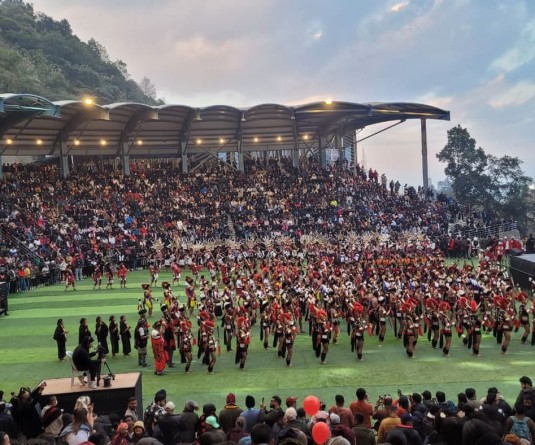Students of Kohima Science College engage in mock drill exercise on earthquake at their campus in Jotsoma on July 18. (DIPR Photo)
NSDMA conduct mock drill exercise on earthquake at Kohima Science College
DIMAPUR, JULY 18 (MExN): The Nagaland State Disaster Management Authority (NSDMA), in collaboration with the District Disaster Management Authority (DDMA) Kohima, organized a mock drill exercise on earthquake at Kohima Science College, Jotsoma on July 18.
During the exercise, Assistant Manager of Training & Education NSDMA, Khrolou Koza Lohe, briefed the students of KSC about the significance of disaster preparedness, citing examples of the damages caused by the Bhuj Earthquake in 2001.
Lohe emphasized the importance of having a disaster management structure in place within schools and colleges, with the Principal as the chairperson. She stressed the need for constituting a disaster management (DM) team, developing a disaster response plan that includes hazard identification, safety assessment, resource mapping (internal & external), formation of various DM teams, and an evacuation plan with designated Assembly Areas.
Lohe highlighted the roles of different teams within the disaster management structure, which include disaster awareness team for warning & information dissemination: responsible for spreading awareness and providing vital information during emergencies; evacuation team for each class with teachers taking charge as leaders to ensure the orderly evacuation of students during disasters.
Search & rescue team would be tasked with locating and rescuing individuals in need of assistance, first aid team to provide immediate medical aid to the injured, fire safety team to handle fire-related emergencies and bus safety team which will focus on ensuring the safety of students during transportation.
Emphasizing on the significance of the mock drill exercise, she said it will serve as a valuable tool to test preparedness and improve the correct methods of conducting such drills. Sensitizing the masses to disaster management measures can significantly reduce the impact of disasters, even though it may not be possible to prevent hazards entirely, she added.
The same mock drill exercise will be held at Living Tree School, Tsiepugei, Kohima on July 20.






